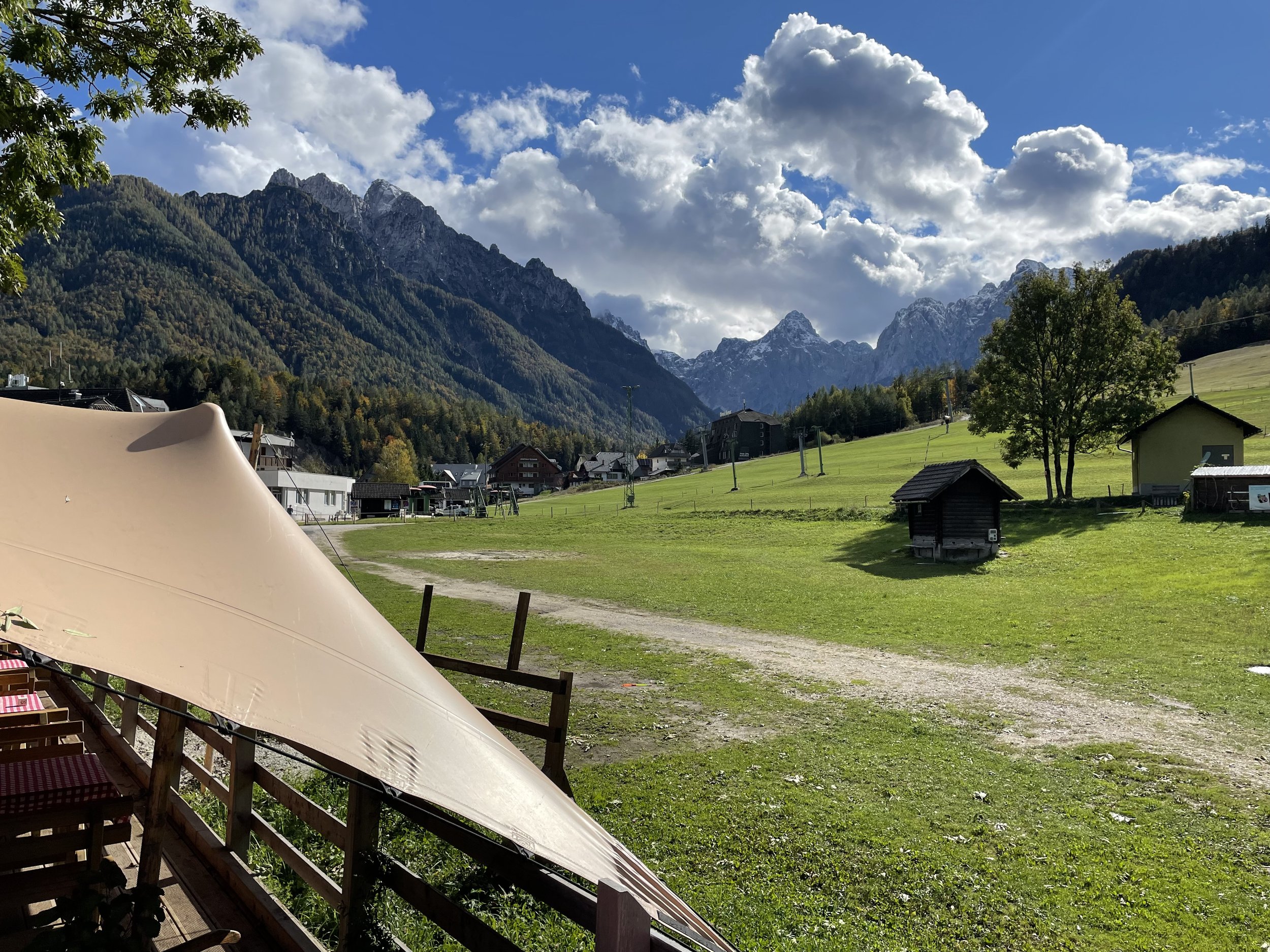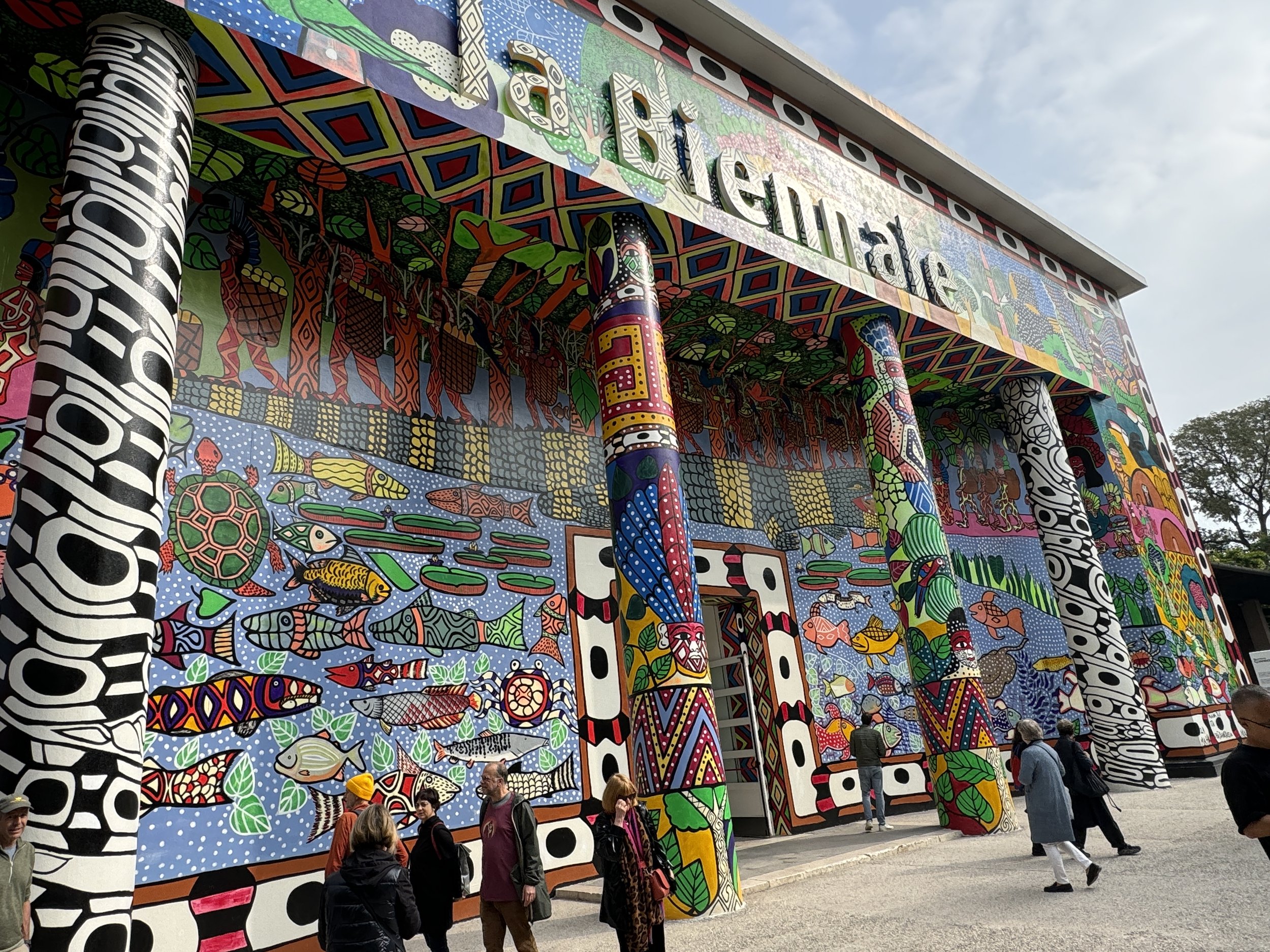Adventure: Slovenia-Croatia-Venice
In mid-October 2024 we flew IAD- LJU and booked in at the Grand Hotel Union, Ljublijana, Slovenia mid-morning. We remained upright and alert as we wandered the streets of this stunning UNESCO town and soaked up the wonderfully festive energy that permeated the rows of riverside cafes. It felt just like a movie set it was so perfectly charming and convivial. A good night’s sleep prepared us for our first day of adventuring.
‘Look Ma, no hands!’ No worries here as we are securely on belay…
Pre-BikeTour Day Via Feratta/ Ljublijana. We booked an exciting Via Ferrata mountain climbing day to warm up for the bike tour. (Contact @Binezalohar directly, our fantastic guide, for more details.) We spent the day climbing exposed rocky cliffs and mainlined adrenaline-filled heights as we hiked through a section of the Gradiska Tura near Vipava. The Via Ferrata is a combination of hiking and mountaineering guided by a steel cable that snakes up the mountain. The route comes equipped with metal cables, iron rungs, pegs, and steps all embedded into the terrain. At times, you might be using ladders and bridges to cross challenging sections, but you are secured with a sturdy, fall-free harness 99% of the time. The trek is somewhat rigorous but relatively hassle free and safe. Via Ferrata is the e-bike of mountaineering—no previous skills or knowledge required—it simply requires an expert guide, good fitness, and a sense of adventure—it’s great fun! There are Via Ferrata routes all over the world and we try to book one wherever we go. We enjoyed Bine’s company so much that day, that we’ll be meeting up with him again in February ‘25 when we ski Chamonix as he is also a ski guide.
After a rigorous and thrilling morning of cliff hanging, Bine introduced us to tiny Faladur Restaurant & Wine Bar (Ulica Ivana Ščeka 6, Vipava 5271 Sloveniaone) easily one of the most unexpected and charming restaurants I’ve ever encountered while covered in dirt. We had a three-course luncheon that felt like a Michelin star experience, and in fact, as we found out later, they are on the recommended Michelin list. The food scene in Slovenia is disarmingly sophisticated and after this delightful repast we had a new appreciation for the gastronomic treats that lay ahead.
For the Slovenia- Croatia biking portion of our trip, we chose the outfitter Backroads the well-regarded bike touring guides who provide bougie travel experiences world-wide. We usually like our trips a bit scrappier—more unknowns and less dialed in for perfection let’s say—but down the road we will need the kind of support and smooth execution Backroads so flawlessly provides, so it was fun to preview what our travels might look like into our seventies and eighties by bicycle. The premier hotels were really beautiful and fit in with our motto of ‘Dirt by day, Lux by night’ very nicely!
Day 1: On the first morning of the trip, we met our twenty-three travel pals for the week and our Backroads Trip Leaders Lara and Johnny K in the lobby of uHotel. We dressed in biking clothes and came prepared with a daypack. Cringingly, we boarded a large tourist bus and shuttled thirty minutes to Kranj, Slovenia. (We dislike shuttles as it cuts down on our daily mileage!) We were greeted by additional guides for the week, two dynamic locals named Kati and Karmen. After a bike fitting and safety talk, plus a few more espressos, we reviewed our ride choices for the day: 1. Kranj to Radovljica Route: 16 Miles (1,400' elevation gain) 2. Kranj to Bled Route: 29 Miles (2,200') 3. Bled Extra Credit Loop: 35 Miles (2,600') Dobrodošli v Sloveniji. Our group was a hearty one, and everyone opted for the long route.
As I enjoyed the chilly ride, I noted that Backroads is true to their brand: we followed the Sava river and rode our way north on exquisitely quiet backroads. We headed to medieval Radovljica, home to one of Slovenia's best-preserved medieval town centers dating back to 1500—it was like something out of a fairytale. We stopped for lunch at a local restaurant that greeted us with bowls of warm pumpkin soup, and then we all pedaled on to Bled, a hauntingly gorgeous town misted in fog. Located in the foothills of the Julian Alps and built adjacent to glacial Lake Bled, this iconic landmark originally gained popularity as a health resort for Austrian aristocracy. In Bled, we visited a family-owned beekeeping farm. Along with a honey tasting, we were enchanted by our guide’s knowledge about beehives, the life cycle of the badass Queen Bee, and the art of extracting honey.
Vila Bled view from the lake.
We arrived at Hotel Vila Bled, an historic and beloved national treasure located on a tranquil slope beside the lake in mid-afternoon drizzle. The place is a time capsule of Yugoslavian history as it served as Tito’s summer retreat. The scale of the hotel is massive, and the accommodations are like apartments. Since the weather was inclement and it was difficult to see the famous views of the lake and the island castle through the fog, we unpacked and rested up for our aperitivo gathering. It was nice to get acquainted with our travel pals a bit better, all American, save for two lively couples from Guatemala, before sitting down to a lovely dinner party in the Great Hall.
Day 2: It was a downpour on day two and our original biking options were scratched: 1. Bohinj Lake with Shuttle Route: 24 Miles* (1,700' elevation gain) 2. Bohinj Lake Route: 30 Miles (3,700') 3. Valley Route: 44 Miles (4,700') 4. Iron Man Pokljuka Route: 55 Miles (7,000'). We rode an abbreviated route and stopped for lunch (completely soaked, but still cheerful) at an adorable cheese farm and regrouped. We all ended up shuttling back to Hotel Bled, soggy and sad. In the evening, things perked up a bit with a reception featuring local wines and a fascinating talk about Yugoslavia’s history given by a resident guide. While influential and controversial, Tito was, and continues to be, historically well liked in the Balkans for his willingness to stand up to Stalin and Hitler. For dinner, we walked up steep cobblestones to visit the Bled Castle Restaurant which is over a thousand years old. This medieval castle sits above the town, and I recommend dining on the early side to fully enjoy the spectacular views of Lake Bled.
Turkish Coffee and Grandma’s Cake
Day 3: Today’s biking options were 1. Kranjska Gora Route: 24 Miles (2,500' elevation gain) 2. Planica Ski Jump Route: 32 Miles (3,200'). After breakfast, we rode directly from the hotel and finally got a clear look at Bled and the beautiful lake. The weather was fine and we were geared up for some fun and miles. We rode into the stunning Radovna Valley, a postcard-perfect alpine valley amid the Julian Alps. We visited the charming village of Mojstrana, which was once a famous mining town, and enjoyed some Turkish coffee and ‘Grandma’s Cake’ at a local inn. The terrain in this area was very dramatic—steep slopes and jagged rocky ledges. As a result, the area has become a popular training destination for Olympic level Slovenian skiers and climbers boasting world-class training facilities. We biked the extra miles to see Planica, the famous ski jumping training area in the Upper Sava Valley. After a spectacular spread for lunch, we rode a converted railway that was—hands down—one of the most beautiful bike paths I’ve ever had the pleasure of riding.
Kempinski Palace Portorož built in 1908.
This spectacular day ended with a shuttle to Portorož for 2.5 hours—didn’t love this part, would much rather be cycling. At least our destination was the pristine coast of Slovenia which owns a modest twenty-nine miles of coastline (Golfo de Venezia), compared with Croatia’s 3,566 miles. I took some long moments to savor this special slice of heaven. Our five-star hotel for the night was on the beach: the grand Kempinski Palace Portorož built in 1908, and we enjoyed strolling the boardwalk. Even though it was chilly outside, we braved an invigorating Wim Hof-style dip in the cool Adriatic sea, which was nothing short of delightfully shocking.
Tonight was date night, and we dressed up ‘a click’ from our usual sporty clothes for a special dinner at the hotel’s Michelin recommended restaurant, Sophia. We don’t care about calories on a bike trip, so we really lived it up with several fabulous courses and a variety of desserts. Slovenain food showcases its creativity by incorporating lots fresh vegetables and lean proteins with expert execution—it’s refreshingly wonderful. While Backroads is a bit pricey, they DO show up in the glam department, I’ll give them that!
Day 4: Biking options: 1. Kempinski to Montizel Route: 22 Miles* (1,900' elevation gain) 2. Kempinski to Montizel with Village Loop Route: 28 Miles (2,700') 3. Kempinski to Livade Route: 32 Miles (2,700') After a short morning shuttle heading south and inland to cross the border, we ceremoniously bid ‘Zbogom’ to sweet Slovenia and ‘Zdravo!’ to chic Croatia. On board our bikes we found the peaceful rolling roads mesmerizing as we wound through dense forests and fig tree groves terraced with virtually no traffic after the busy initial climb. We stopped for a coffee in the adorable hilltop town of Groznjan, where there was a raging Mountain Bike downhill competition underway, and the town was abuzz with excitement. After snooping around the cute shops, we pedaled on a few more kilometers, climbing out of town towards our destination: an agriturizmo (a working farm open to visitors) for a delicious lunch of traditional fare and spectacular views of the Croatian landscape. After lunch, we made our way towards the town of Livade, which is famous for the fragrant and elusive truffle and arrived mid-afternoon at the stunning, Wine Hotel Meneghetti via shuttle. We spent the afternoon relaxing at the hotel—exploring the beautiful grounds and gardens—and enjoyed a swim in the spa. In the evening we shuttled to the nearby seaside town of Rovinj for a quiet dinner and walking tour of the harbor’s lights and sights.
The Wine Hotel Meneghetti was chic and comforatble and we could have happily stayed here a week!
Day 5: Biking options: Meneghetti to Konoba Lunch Route: 27 Miles (2,100' elevation gain) Meneghetti to Polidor Beach Route: 41 Miles (2,500') BOAT RIDE TO PEROJ PORT 1½ Hour). We fueled up at breakfast for our final day on the bikes. We rode from the hotel toward the Venetian town of Bale where we stopped for an olive oil tasting at the charming family-owned GRUBIC BUZA Olive Oil Mill. After some samples and snacks, we set out riding through the striking landscape of central Istria, passing ancient forests, tiny villages, castle ruins and the remains of Medieval towns. We enjoyed a short history lesson about Dvigrad, an abandoned village initially settled by the Illyrians in a prehistoric era. We stopped at a konoba for lunch before venturing to the speedboat that awaited us seaside. We dropped anchor near a remote island and lobbed some chilly cannonballs into the crystalline waters—it was exhilarating! Later on, the speed boat and shuttle returned us to the Meneghetti and our beautiful suites. We were all eager to spend more time in the tranquility of the hotel setting, and it felt like a well-earned rest after five days of biking and socializing. In the evening, we joined our lively group for a farewell aperitivo and then dined together, savoring a superb week of adventuring and toasting new friendships.
It’s always better by bike!
Backroads Day 6: We enjoyed a leisurely morning pace and a grand breakfast on the final day of our magical Backroads trip. It was time to switch gears, pack, and head to Venice for a few unstructured days of exploring the culture, art, and food of this unique city. After many hugs and farewells we bid our traveling pals and guides good-bye and were dropped off at the Trieste train station. It took us a few minutes to orient, but thanks to a kind man from Malta, our two-hour journey into Venice was very smooth. The sharp staff of the JS Marriot spotted us right away and boarded us onto one of their classic motorboats to ferry us to the Isola Delle Rose (Rose Island) that is the JW Marriot Venice Resort and Spa campus—our home for the next three nights.
Venice: Days 7, 8, 9. Our brief stay in Venice was unplanned and we began each morning aboard the hotel’s water taxi ferrying to the San Marco Pier. We walked miles in this vibrant, quirky city—The Queen of the Adriatic—taking in the shops, Rialto Bridge & Market, San Marco’s Square (Piazza San Marco) and all its majestic sites—Saint Mark’s Basilica (Basilica di San Marco), Doge’s Palace (Palazzo Ducale) and the Saint Mark’s Bell Tower (Campanile di San Marco) to name just a few. As we toured, the songs of the many Gondoliers—lovely barcarolles—echoed off the water adding a charm and joy to the atmosphere that captured the special feeling of being in Venice.
Venice’s dramatic history rests quietly within the elaborate architecture and vast network of waterways and it makes for a mind-boggling tourist experience. There is so much to absorb that we needed to take many Cappuccino breaks (‘Macchiatos’ after 11!) as we immersed ourselves into the vibrant scene, happily getting lost in the back alleyways and jazzed by the people watching. Fortunately, we visited in late October when the crowds were milder and we had easier access to the charming restaurants (Nevodi for pasta!) and museums.
One surprise event we absolutely thrilled to was visiting the Venice Biennale 2024, a prestigious cultural exhibition that showcases cutting-edge contemporary art, architecture, cinema, dance, music, and theater—depending on the year’s theme. The exhibits were spread over two large campuses and each country had its own building and featured artist. This year’s theme was ‘Foreigner’s Everywhere’ which explored the ideas of identity, belonging, and the complexities of being a ‘foreigner’ in a world increasingly interconnected yet divided. It was ideal to expereince such a variety of art while on a walking tour—perfect for ‘restless us’, since biking is not a thing in Venice!
We took a tour of the two most famous islands, Murano and Burano, to experience the ancient glass-making process and to visit a colorful fisherman’s village. Of the 117 Venetian islands, these two are the most touristy—and we embraced them for an enjoyable afternoon of Venetian culture. And then just like that, it was time to go home. We were sad to leave colorful, funky Europe—but we are always glad to return home to our beloved Vermont.
I’d love to hear from you—feel free to send your comments to me. Please share this post with a friend :) and thank you for reading!















































